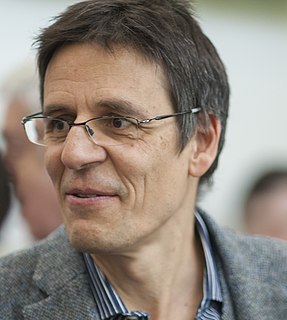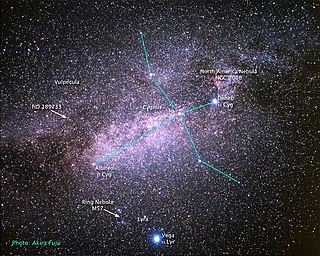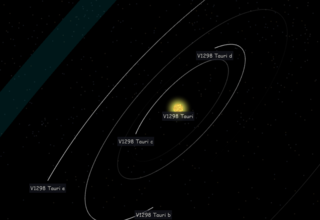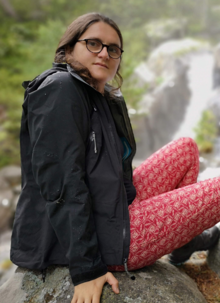
An exoplanet or extrasolar planet is a planet outside the Solar System. The first possible evidence of an exoplanet was noted in 1917 but was not recognized as such. The first confirmation of detection occurred in 1992. A different planet, initially detected in 1988, was confirmed in 2003. As of 1 September 2022, there are 5,157 confirmed exoplanets in 3,804 planetary systems, with 833 systems having more than one planet.

CoRoT was a space telescope mission which operated from 2006 to 2013. The mission's two objectives were to search for extrasolar planets with short orbital periods, particularly those of large terrestrial size, and to perform asteroseismology by measuring solar-like oscillations in stars. The mission was led by the French Space Agency (CNES) in conjunction with the European Space Agency (ESA) and other international partners.
51 Pegasi, formally named Helvetios, is a Sun-like star located 50.6 light-years from Earth in the constellation of Pegasus. It was the first main-sequence star found to have an exoplanet orbiting it.

Hot Jupiters are a class of gas giant exoplanets that are inferred to be physically similar to Jupiter but that have very short orbital periods. The close proximity to their stars and high surface-atmosphere temperatures resulted in their informal name "hot Jupiters".

Didier Patrick Queloz is a Swiss astronomer. He is the Jacksonian Professor of Natural Philosophy at the University of Cambridge, where he is also a fellow of Trinity College, Cambridge, as well as a professor at the University of Geneva. Together with Michel Mayor in 1995, he discovered 51 Pegasi b, the first extrasolar planet orbiting a sun-like star, 51 Pegasi. For this discovery, he shared the 2019 Nobel Prize in Physics with James Peebles and Michel Mayor. He is designate director of the new Center for the Origin and Prevalence of Life at ETH Zurich.

HD 189733, also catalogued as V452 Vulpeculae, is a binary star system approximately 64.5 light-years away in the constellation of Vulpecula. The primary star is suspected to be an orange dwarf star, while the secondary star is a red dwarf star. Given that this system has the same visual magnitude as HD 209458, it promises much for the study of close transiting extrasolar planets. The star can be found with binoculars 0.3 degrees east of the Dumbbell Nebula (M27).

Any planet is an extremely faint light source compared to its parent star. For example, a star like the Sun is about a billion times as bright as the reflected light from any of the planets orbiting it. In addition to the intrinsic difficulty of detecting such a faint light source, the light from the parent star causes a glare that washes it out. For those reasons, very few of the exoplanets reported as of April 2014 have been observed directly, with even fewer being resolved from their host star.

51 Pegasi b, officially named Dimidium, and formerly unofficially dubbed Bellerophon, is an extrasolar planet approximately 50 light-years away in the constellation of Pegasus. It was the first exoplanet to be discovered orbiting a main-sequence star, the Sun-like 51 Pegasi, and marked a breakthrough in astronomical research. It is the prototype for a class of planets called hot Jupiters.
Kepler-17 is a main-sequence yellow dwarf star that is much more active than our Sun with starspots covering roughly 6% of its surface. Starspots are long-lived, with at least one persisting for 1400 days.

Planet Hunters is a citizen science project to find exoplanets using human eyes. It does this by having users analyze data from the NASA Kepler space telescope and the NASA Transiting Exoplanet Survey Satellite. It was launched by a team led by Debra Fischer at Yale University, as part of the Zooniverse project.
Kepler-88 is a Sun-like star in the constellation of Lyra, with three confirmed planets. In April 2012, scientists discovered that a Kepler candidate known as KOI-142.01 (Kepler-88b) exhibited very significant transit-timing variations caused by a non-transiting planet. Timing variations were large enough to cause changes to transit durations to Kepler-88b as well. Large transit-timing variations helped to put tight constraints to masses of both planets. The non-transiting planet was further confirmed through the radial velocity method in November 2013.
Kepler-102 is a star in the constellation of Lyra. Kepler-102 is less luminous than the Sun. The star system does not contain any observable amount of dust. Kepler-102 is suspected to be orbited by a binary consisting of two red dwarf stars, at projected separations of 591 and 627 AU.
Catherine Jane Clarke is a Professor of Astronomy at the University of Cambridge and a fellow of Clare College, Cambridge. In 2017 she became the first woman to be awarded the Eddington Medal by the Royal Astronomical Society.

Carole Ann Haswell is a British astrophysicist and current Professor of Astrophysics and Head of Astronomy at the Open University. She is a Fellow of the Royal Astronomical Society. She has been involved in the detection of several exoplanets, including Barnard's Star b.

V1298 Tauri is a young weakly-lined T Tauri star that is part of the Taurus-Auriga association in the Taurus Molecular Cloud. Alternatively it is part of a proposed moving group, called Group 29 that is slightly older. The system has four transiting exoplanets, discovered with the Kepler space telescope in the K2 mission. One of the planets was discovered in August 2019 and the other three were discovered in November 2019 by the same team.










